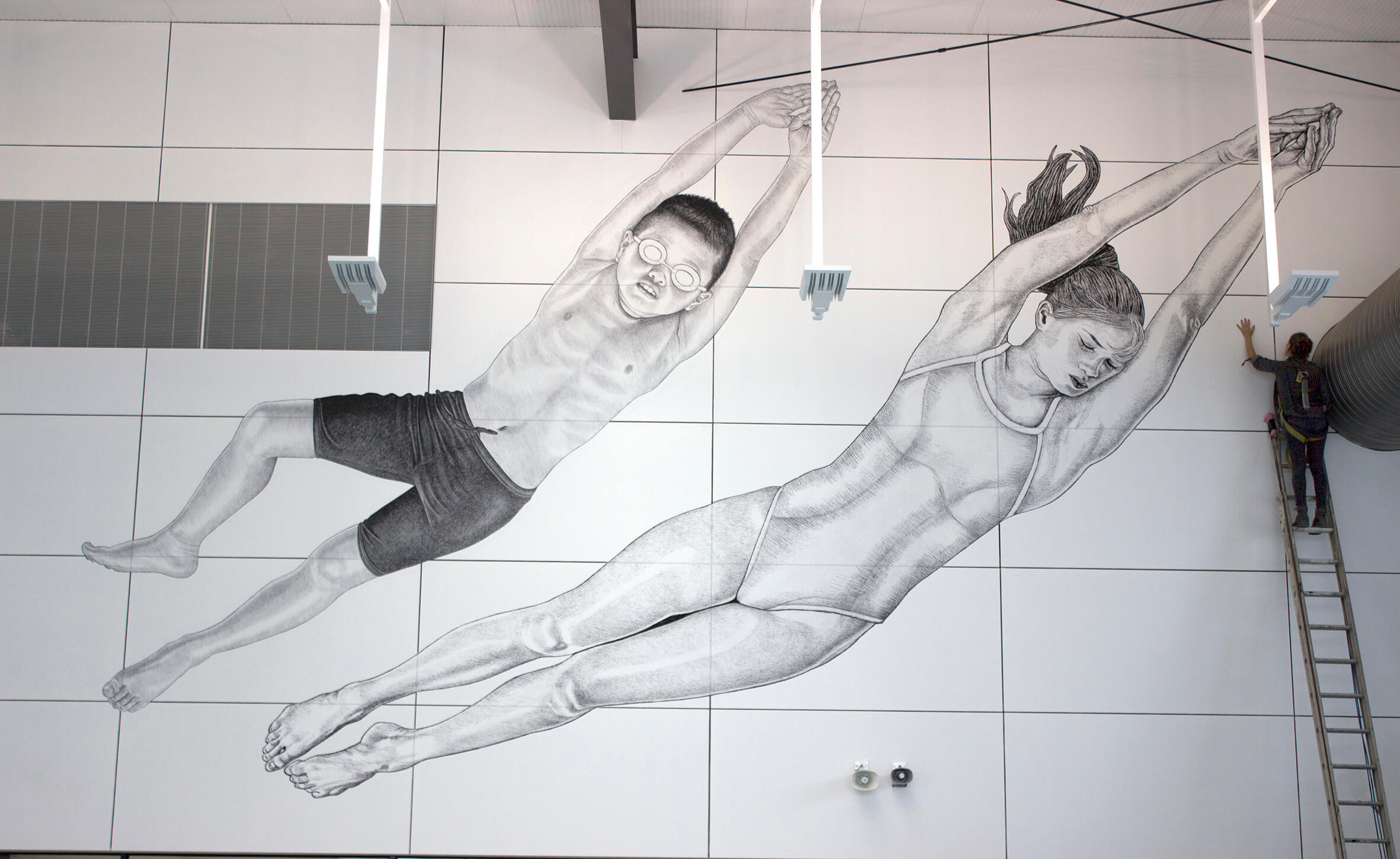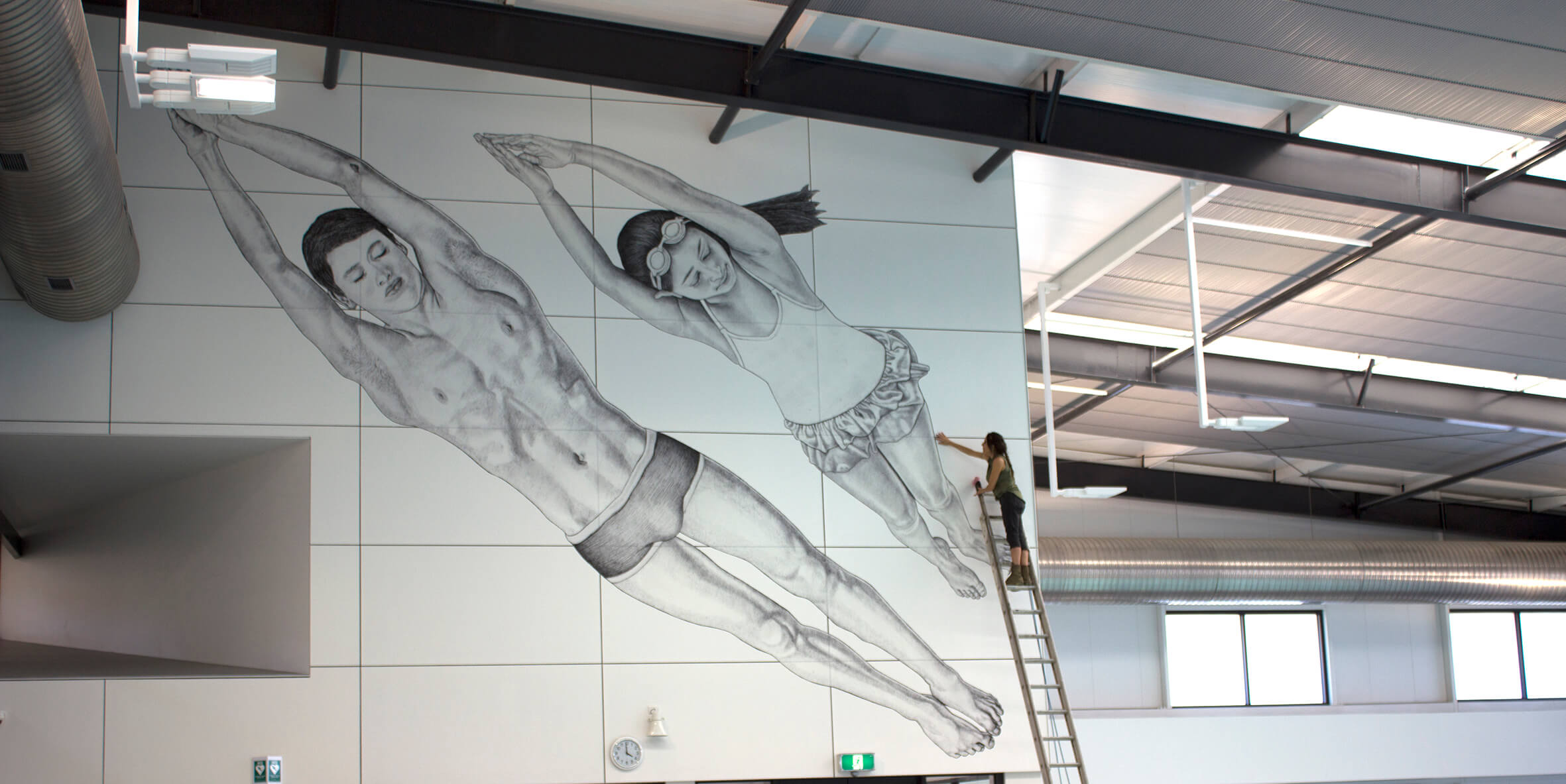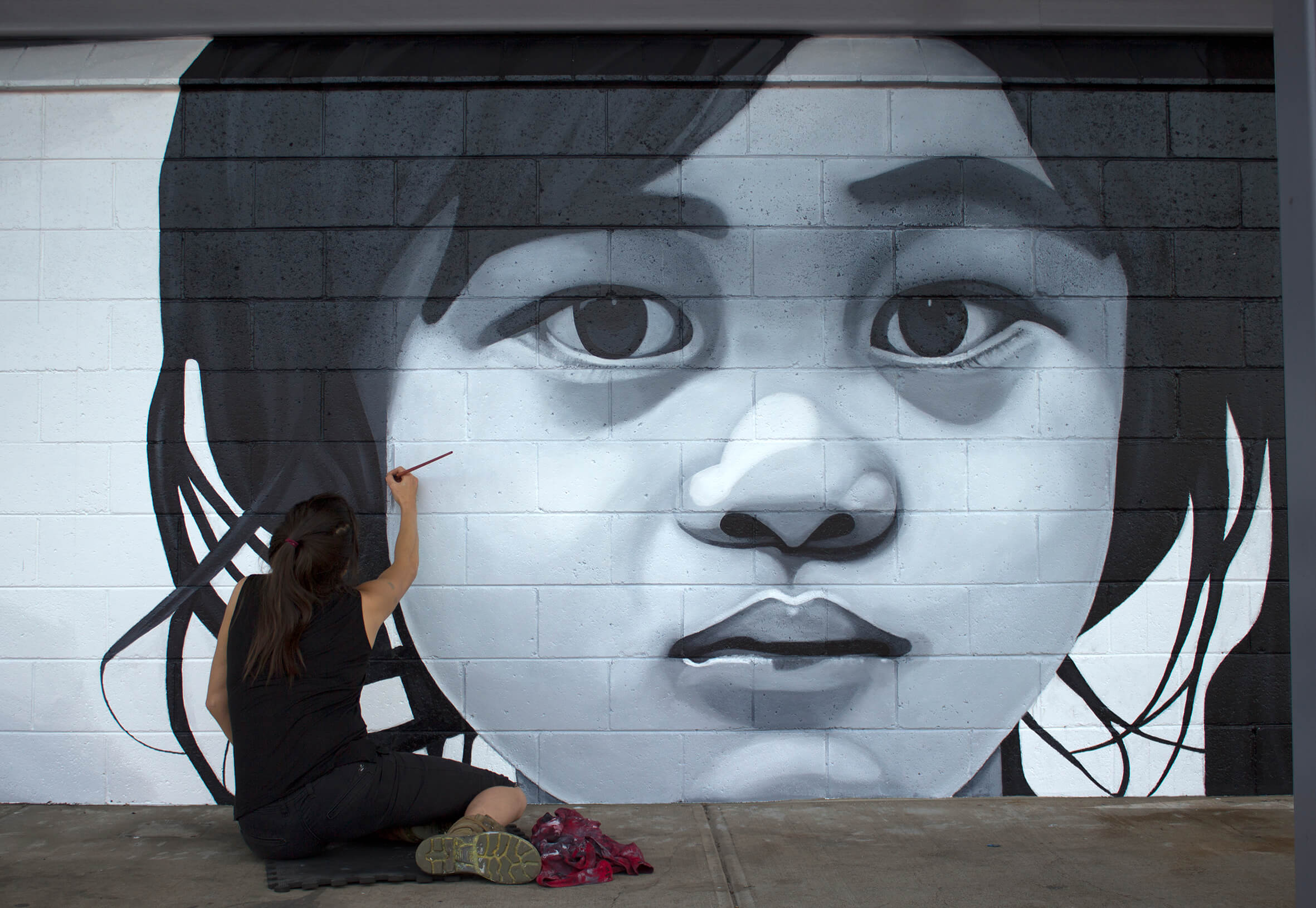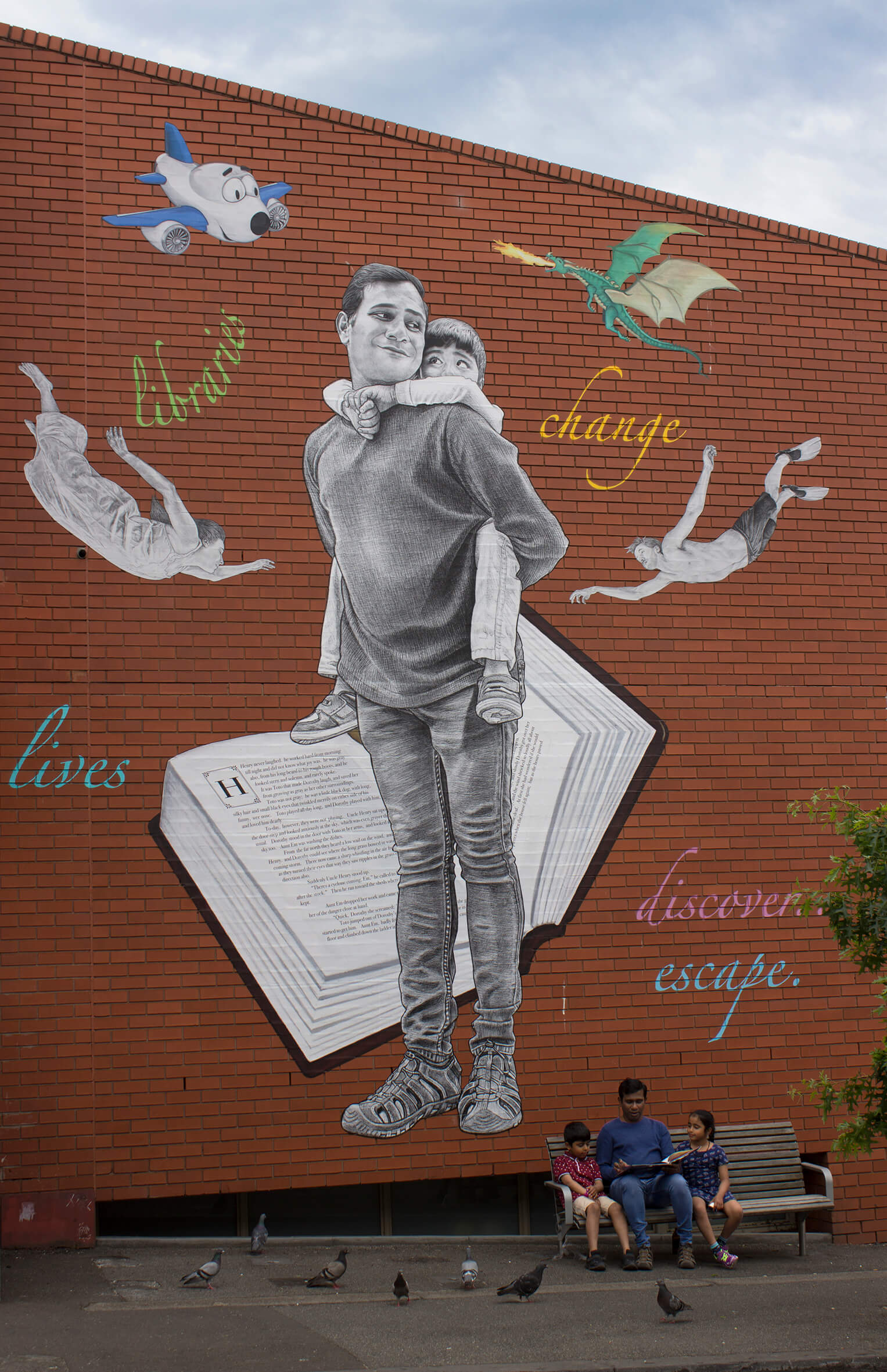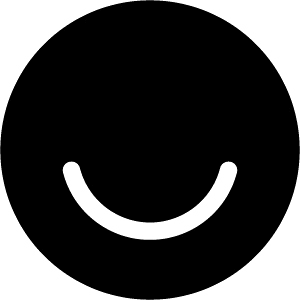I absolutely love the democratisation of art – no barrier to an artist putting their work out there and speaking directly to an audience without needing approval from any third party.
In her street art works, Melbourne-based artist Baby Guerrilla’s protagonists are often in a state of floating. Some of them seem to be in a trance and some in a state of transition or transformation mid-air. Some of them are being held onto by others. What’s common amongst all the stories is that they are completely open to a wide variety of interpretations.
While the street art works seem to take a flight of imagination and fantasy, her paintings are often rooted in intuitions and reality. In fact, some of her paintings have turned out to be a harbinger of reality. I asked BG about some of the portraits she did of lone workers wearing bio-hazard suits – one of them in a local train after what looks like a terribly busy day at work and one alone at a dining table in an artwork titled ‘Last Supper’. I had presumed that she did these artworks during the pandemic, however, she told me, “I was having recurring images about the pandemic back in 2010 and felt compelled to paint isolated people in bio-hazard suits with masks on.” As spooky as that sounds, it’s also a testimony to the intuitive powers of artists and art.
After graduating from the Victorian College of the Arts, BG had anticipated the rest of her life as a painter. Street art started as a hobby for her, but it slowly became a very prominent part of her life. She now sees the two mediums as complimentary. Apart from these two mediums, she also has created compelling work in the form of drawings, installations, mixed-media art, and performance art.
We speak to BG about her work and life:
Could you tell us about your childhood?
I grew up in Sunshine/Braybrook in the Western suburbs of Melbourne. I had loving, supportive parents and a very large family. Times were different then, as we were free to roam around but there was also much less known about issues such as mental health. There was some complex tragedy and loss in my childhood as well. Making art has been a way of processing life, the highs and the lows and everything in between.
What were your early creative influences? You have mentioned in an interview that some of your earliest memories are being fascinated by pattern and colour, and that you always knew you were going to be an artist.
I was always interested in anything art-related. My teacher in primary school used to draw a new pattern on the blackboard every morning for all of us to look at and that was the most exciting part of each day for me; just waiting to see what she’d draw next. I remember going to school when I was 7 or 8 years old one morning and noticing someone had graffitied a wall and written ‘hip-hop’ in colourful lettering with a boombox next to it. It blew my young mind. I thought it was one of the most beautiful and creative things I had ever seen. I was transfixed!
I was one of those kids who always knew exactly what they wanted to be from an early age. Even before I could draw and paint, I remember pondering intellectual and technical riddles that still form the basis of art making for me. I was observing the impact of certain colours together or trying to think how would I make, say, a life-size person?
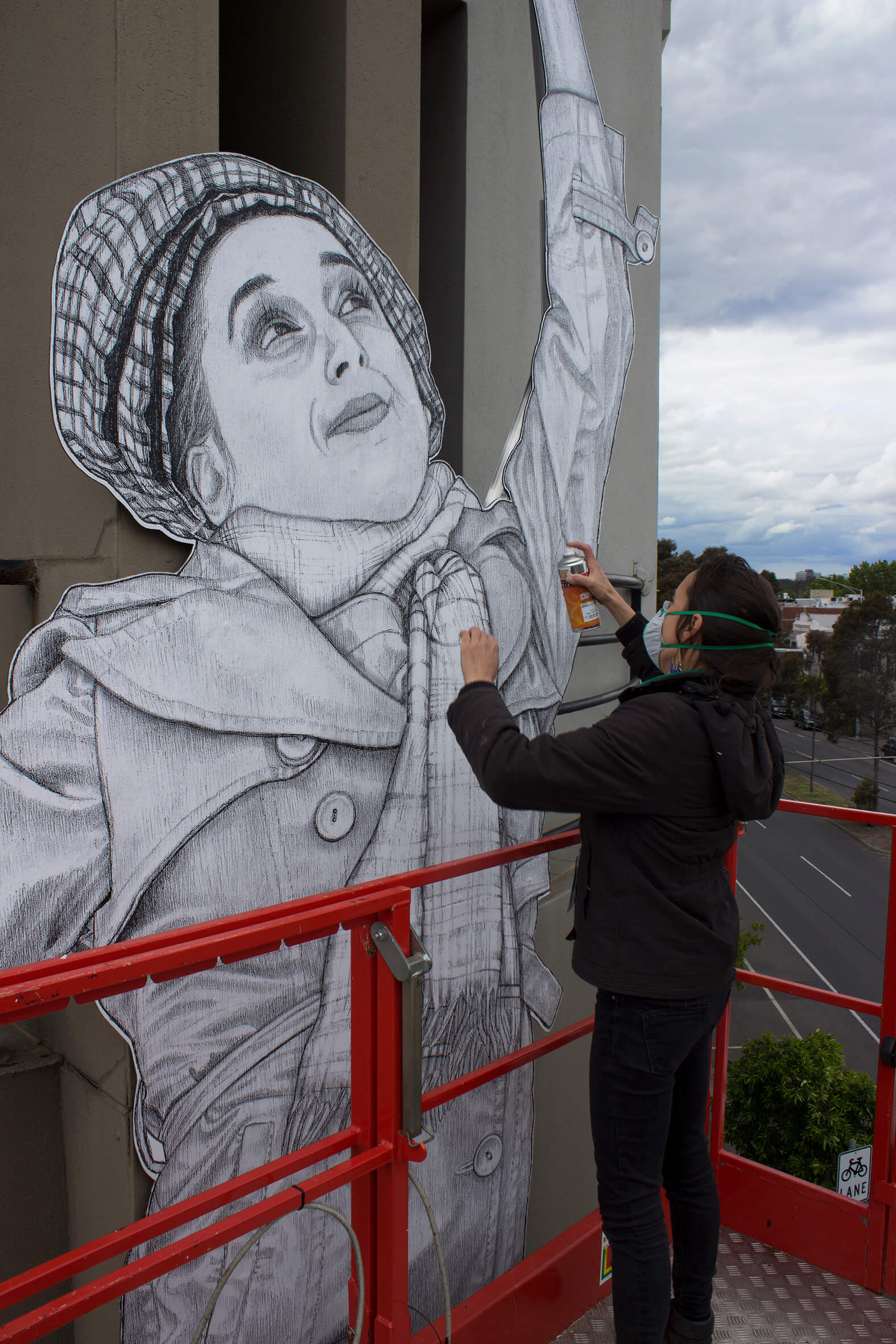
Baby Guerrilla
It would be amazing if we protected what was important and became kinder to each other and the environment. We need a new economic model – one that puts people and places over profit. I have heard the theory that the Earth is bucking us – the invasive species – off it and is doing what it needs to survive. That is a fascinating theory. How do we help and heal the Earth, from the damage we have done?
What were some of the challenges you faced when you started out as an artist initially?
There are a lot of issues that stem from financial challenges, such as secure housing. I think isolation can also be a big challenges for artists and the mental health challenges that can bring about as well. This is one of the appeals of public art for me – connecting with other people and a much broader audience. Working on projects for other people takes you outside of your own sphere.
What were some of your initial street artworks about?
My first street works were fairly autobiographical depictions of tiny women falling naked from the sky. They reflected my own vulnerability, a longing for connection and somewhere to land.
I am curious to know the inspiration and vision behind the photography/performance art piece on your website – about the girl in the wedding dress.
The traditional white wedding dress is such a loaded symbol, laden with centuries of cultural, symbolic, and historical references. There is so much that could be written about the significance, symbolism, and history behind this object. It has ties to a patriarchal structure that goes back centuries and a white colonial power structure that has done a lot of damage to both people and the environment. The performances reflect some of the reality and suffering that lies beneath this fairytale which we have passed down from generation to generation. It also reflects the mismatch between my own life and this archetype continually presented by culture and society, and how I have seen it damage women so deeply.
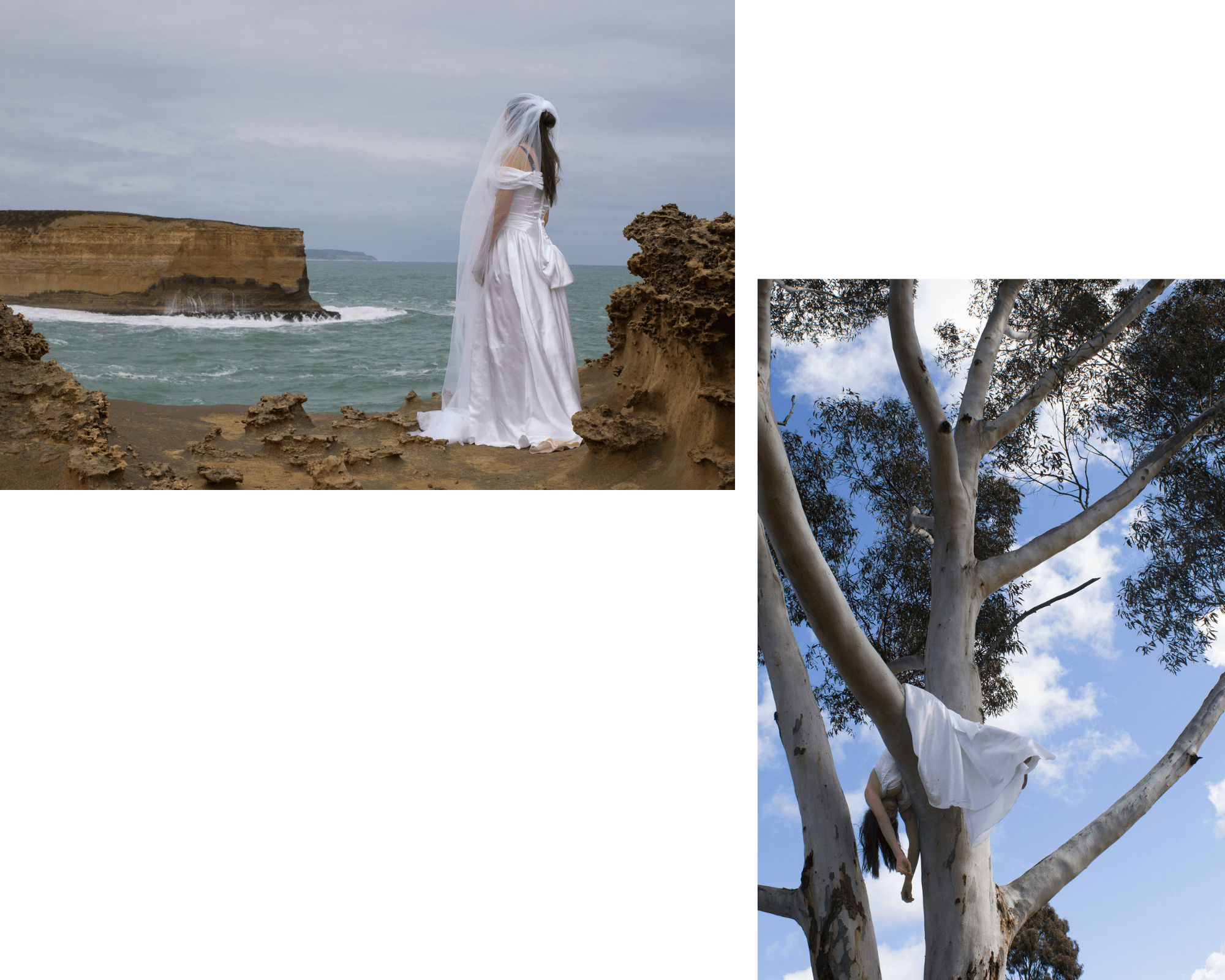
How has the pandemic/lockdowns experience for you personally? How challenging has it been?
I was very lucky in regards to the lockdown; a couple of my projects were delayed but I have had steady work throughout. I think isolation is something which many artists are very familiar with. My heart goes out to all those people who were affected. I am very fortunate to not have been shut down in that way.
To hear the arts, music and comedy labelled non-essential felt unjust as those are the things that give life colour, meaning and connection (to name only a few benefits!). The pandemic only strengthened that sense for me. I can’t imagine a world without music, art, and the humanities.
Could tell us about some of the work you managed to create during the pandemic? I saw some really poignant paintings about it on your website.
Probably like many artists, my work has a very intuitive aspect to it. I believe we are all connected to a higher consciousness or that there is an intelligence to the universe which we sometimes glimpse. This has happened to me so frequently with my work. I was having recurring images about the pandemic back in 2010 and felt compelled to paint isolated people in biohazard suits with masks on. Making art is a really fascinating process. I love the mystery and the messages received, the connection to a higher consciousness and the beauty that surrounds us.
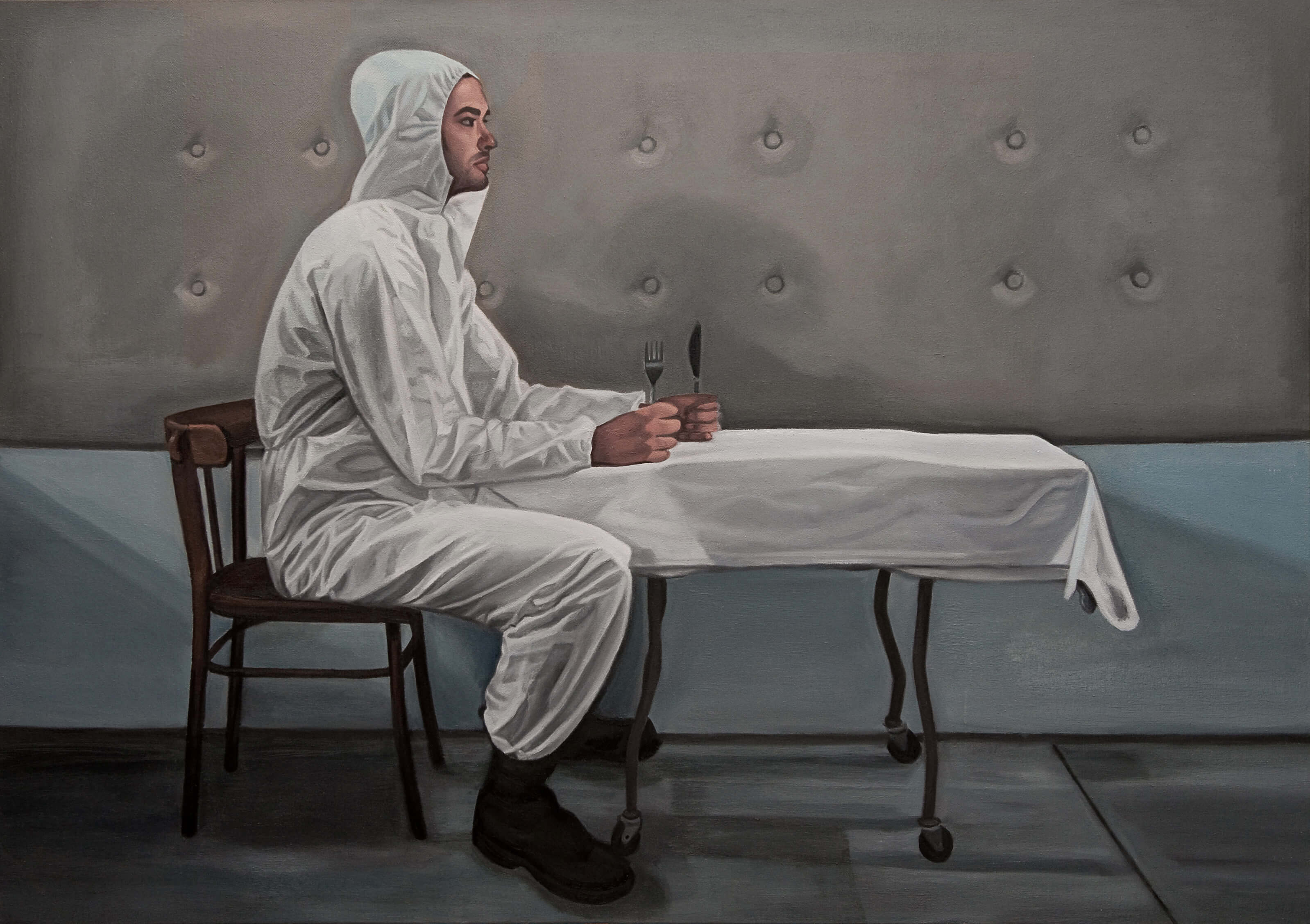
What, according to you, is the role of an artist in today’s world? Some people believe in art for art’s sake and some feel that art should lead to change. How do you feel about this?
Diversity is key. There is no one role or definition. All positions are valid. Art can be an armchair or a sledge hammer and everything in between. We need all the different voices. Maybe together we can form some type of choir (laughs).
How do you feel about the impact of your work – especially street art work?
It’s hard to comment on the impact of my work. I hold it so close and put my heart and soul into it but after it has gone out into the world, I don’t really feel like I own it. If even one person gets something from it, I am grateful.
Not only does street art democratise art, it also gets the most widespread/instant feedback. How do you feel about the medium in this context?
I absolutely love the democratisation of art – no barrier to an artist putting their work out there and speaking directly to an audience without needing approval from any third party. It is a little bit like surfing, nothing to stop anyone from getting up. It is a fairer system in my opinion, as I am not a fan of despotic power structures.
I think both sharing art on the internet and public art in general make art more accessible to a much wider range of people who might never have the chance to visit an art gallery. With feedback on the internet in general, if I see someone sledging another person, I almost always think it shows a lack in the person doing the sledging. If you don’t like someone’s work, do something better. There is more to life.
“I also became involved because I was frustrated with the art world hierarchy.” – You mentioned this in one of your interviews in reference to getting into street art. How do you see it evolving in the future? Do you think that with digital mediums, artists are becoming more and more independent of the gallery structures?
I think this has already happened and I love it. Artists are no longer solely dependent on the gallery hierarchy to sustain a career or income.
What are some of the other things that bother you about the art world in general?
I think it would be good if artists had a CFMEU (The CFMEU is a powerful union for the building industry in Australia) or a more powerful union like actors have.
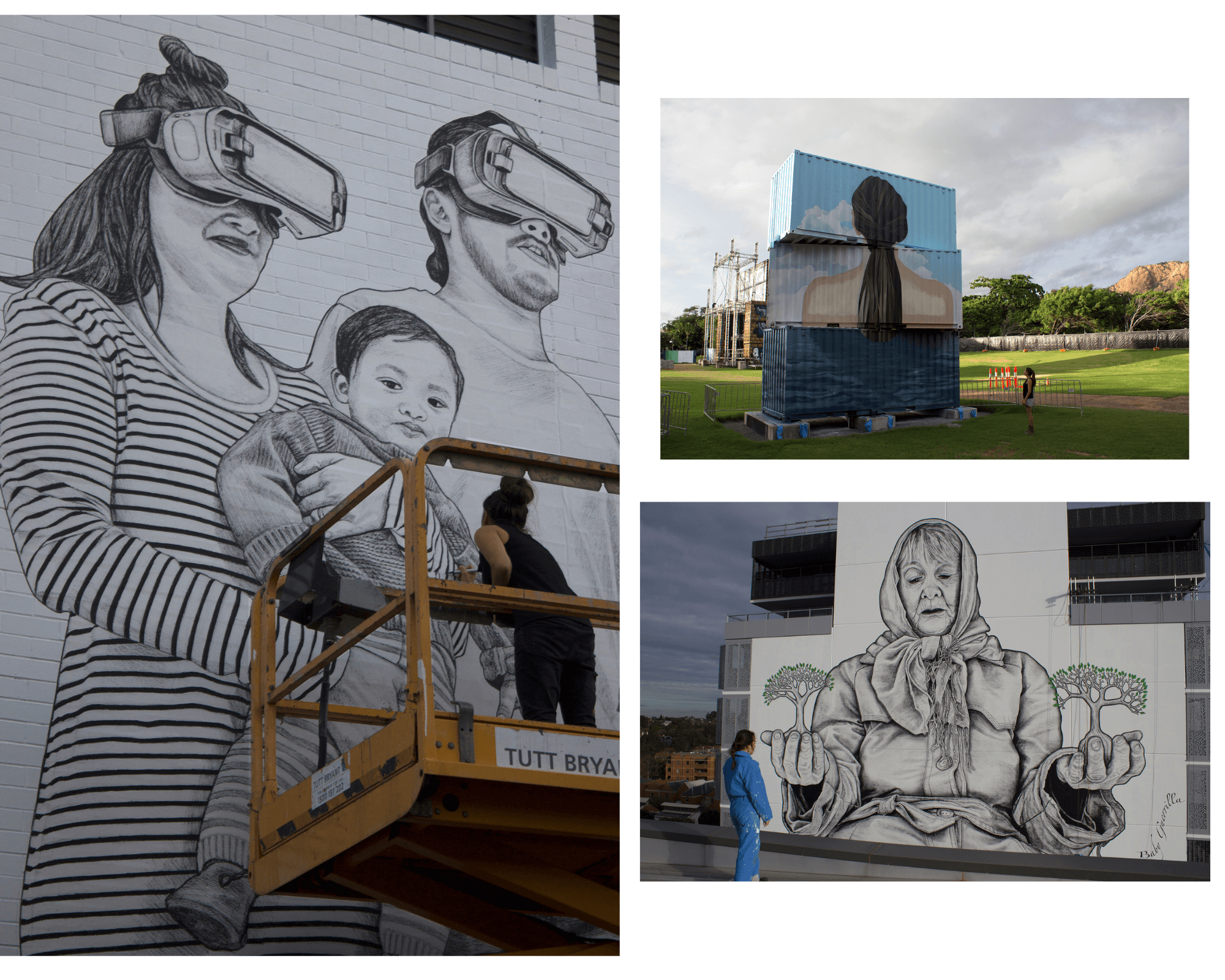
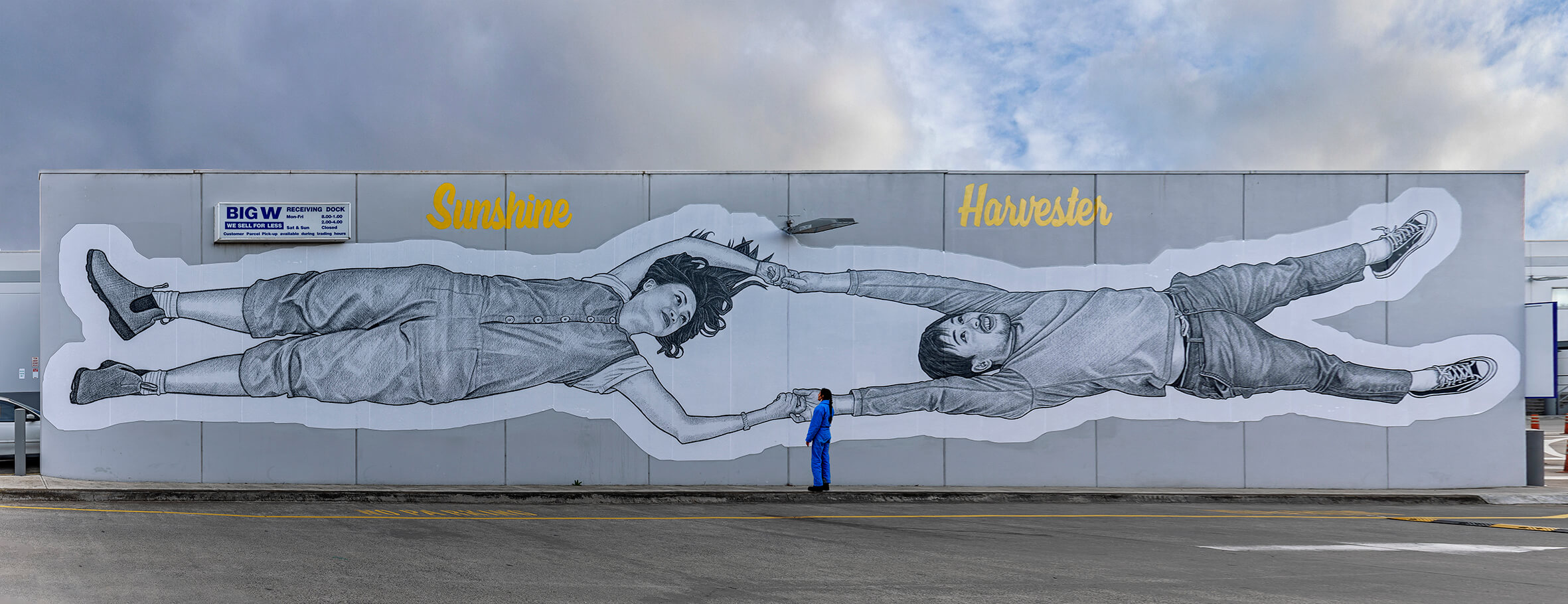
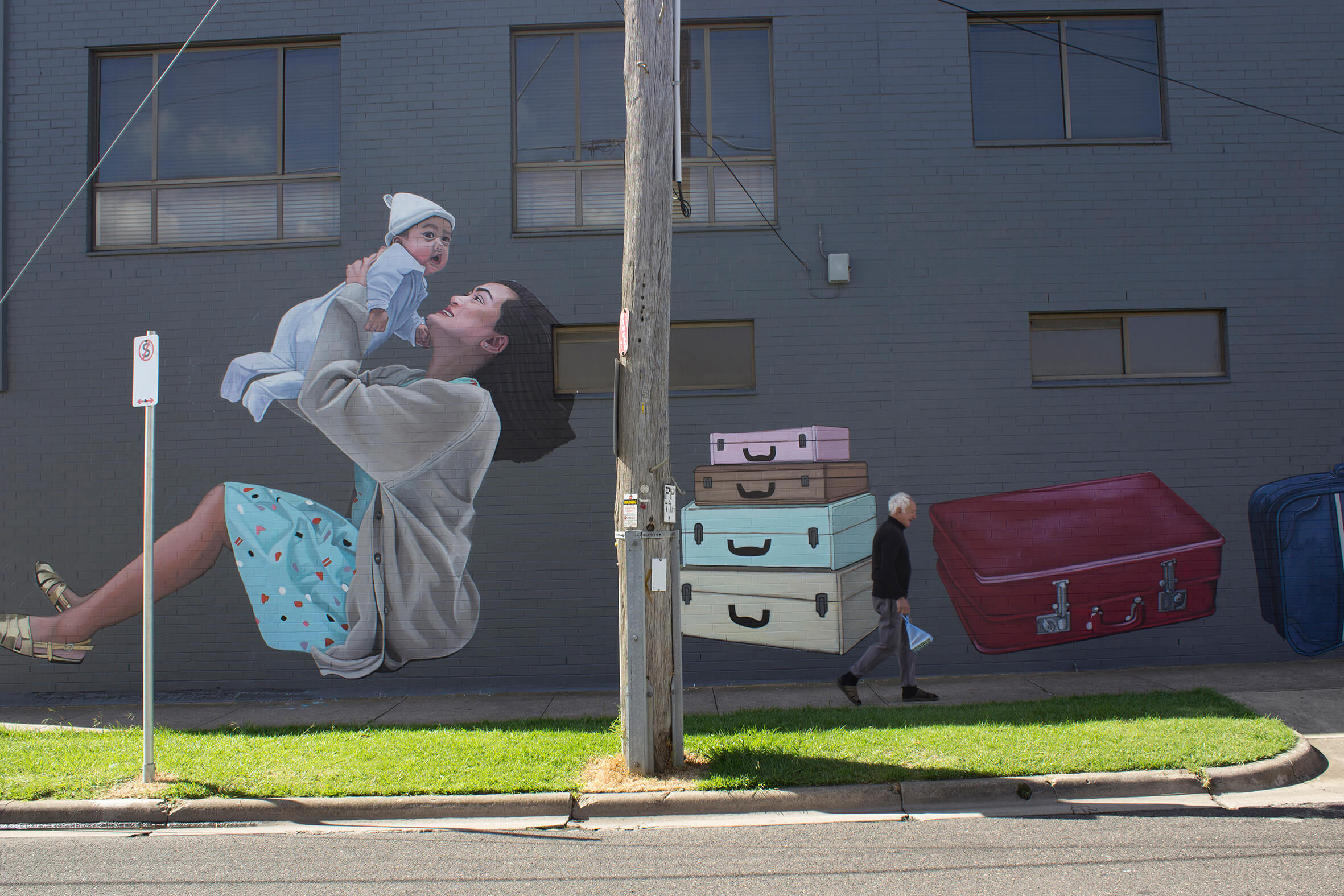
What are some of the issues you are currently most passionate about?
It would have to be the environment and the health of the planet we live on.
How do you draw a balance between personal projects and commissioned projects?
I don’t see too much of a conflict between the two. I try to make all types of projects or commissions a part of my own practice. I find an angle or aspect that draws me in and hopefully extends my work. I don’t see myself as a commercial artist. If something doesn’t sit right with me or if I am told to do something that doesn’t sit right with me, I just won’t do it.
What are some of the sources from which you draw inspiration?
Music, comedy, and books are all massive for me – anything that restores the soul such as being out in nature, cooking, family, friends, love, the horizon – any time of day!
‘Beloved’ by Toni Morrison is one of my favourite books that I have read in the past couple of years. I also just finished comedian Becky Lucas’s new autobiography which I enjoyed. I love a wide range of music. Recently, I have been listening to Baarka – ‘Let Them know Something’, Briggs, Mary Gauthier, Ane Brun, Maggie Rogers, and Feist.
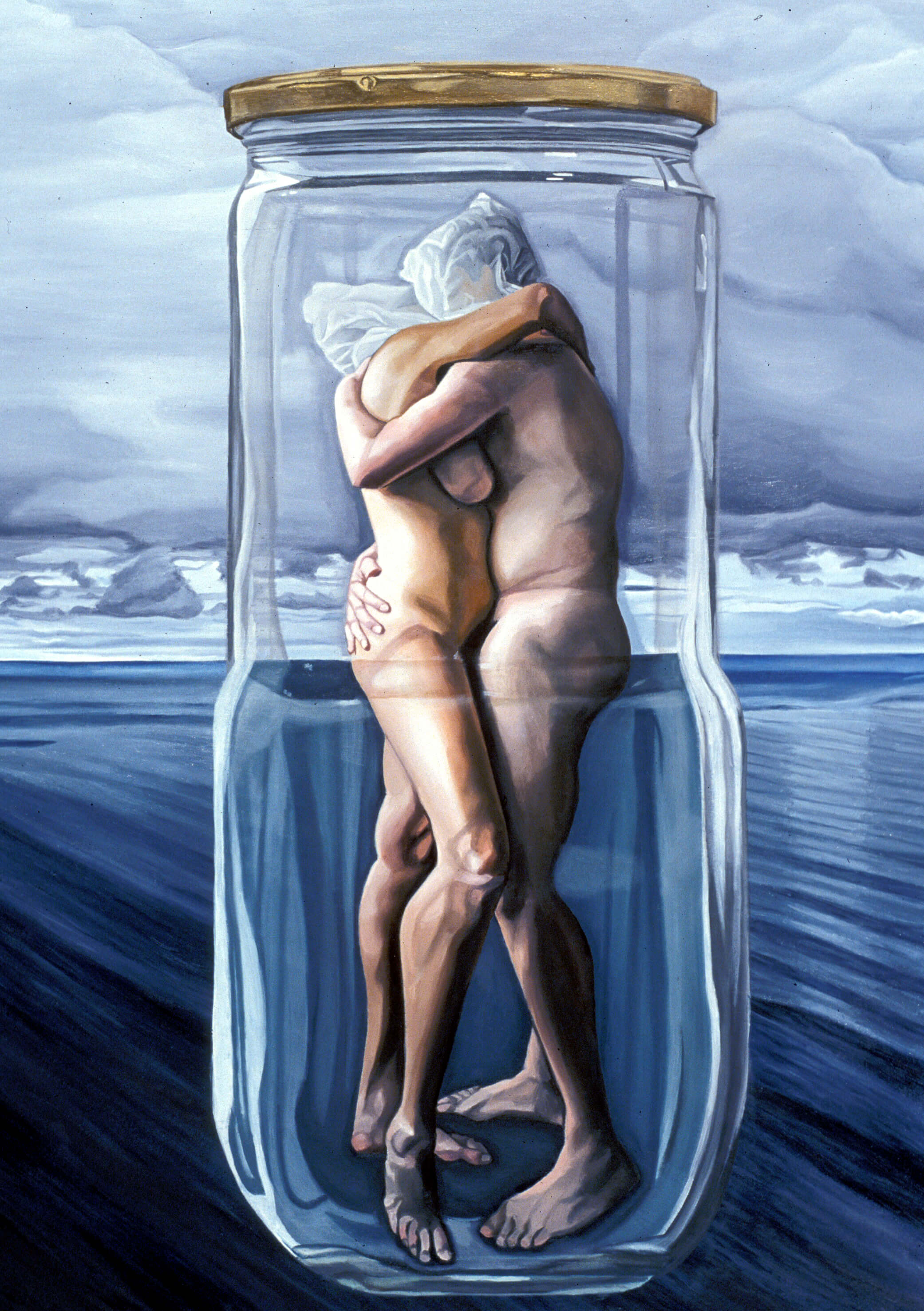
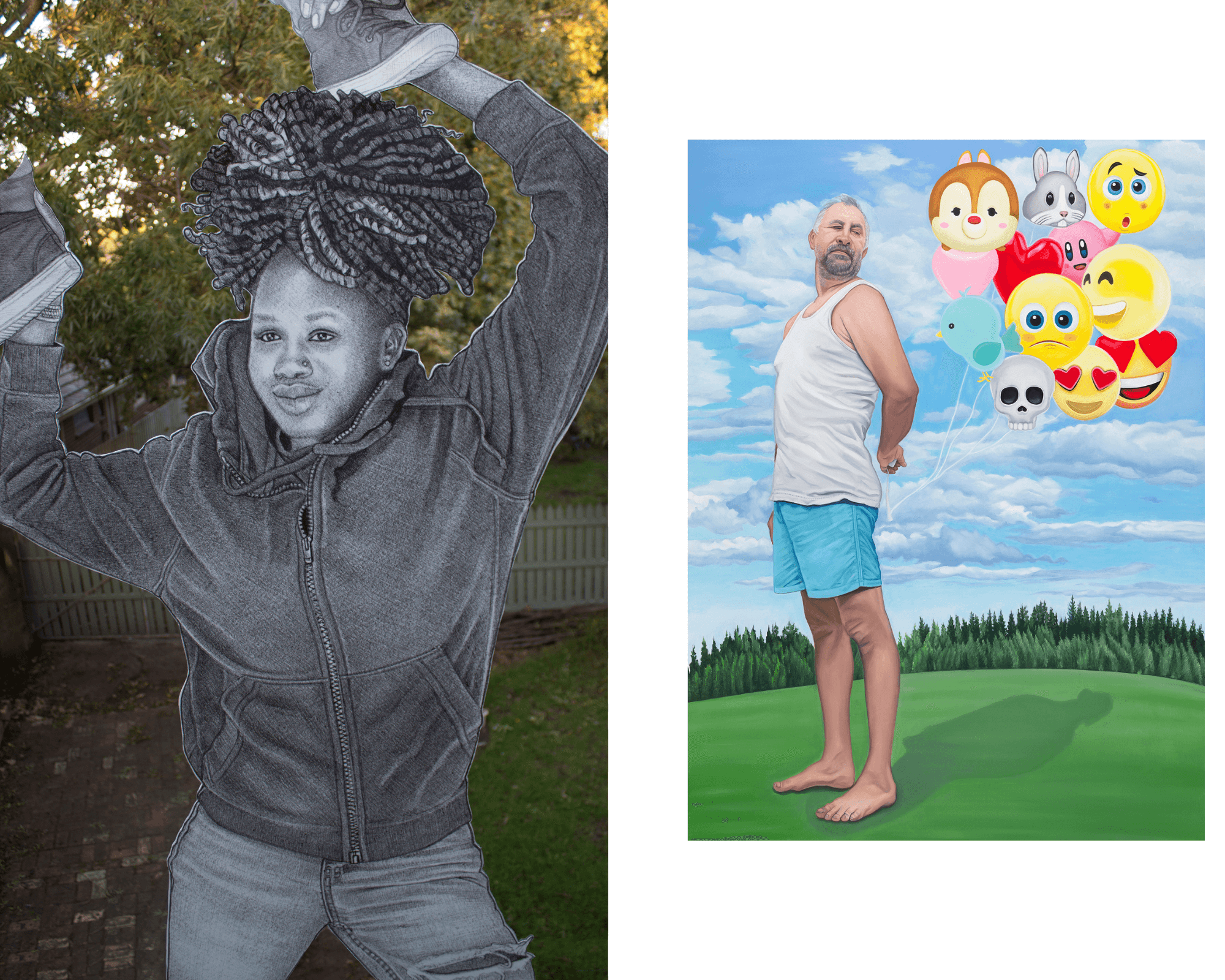
How does living in Melbourne impact your creativity?
It is a bit funny because I have never been able to afford the inner city, somewhere like Fitzroy, or Northcote. For a brief time, I lived in West Footscray, but the rents there have really soared, so I moved further out. I grew up in Sunshine/Braybrook and have spent a lot of time in the least fashionable suburbs, most recently in Corio in Geelong. Fortunately I can make art anywhere! I probably personally identify more with the low socio-economic suburbs too. I do find the wealth, colour, fashion, and food of the inner city very exciting but creativity is everywhere.
What are your hopes and vision as we slowly (very slowly actually with all the variants around) try to emerge out of the pandemic?
I think the pandemic has shown us the things that give our lives meaning and joy, and that it wasn’t all mindless consumption. It would be amazing if we protected what was important and became kinder to each other and the environment. We need a new economic model- one that puts people and places over profit. I have heard the theory that the Earth is bucking us – the invasive species – off it and is doing what it needs to survive. That is a fascinating theory. How do we help and heal the Earth, from the damage we have done?
